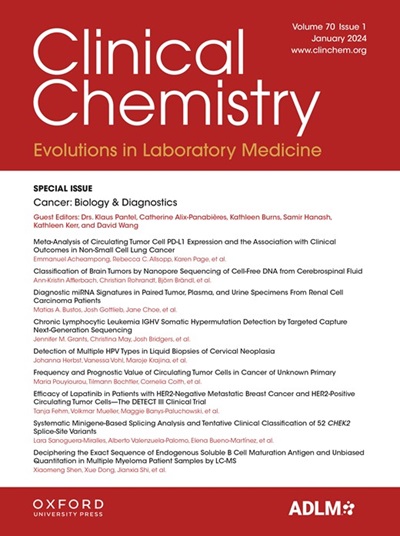B-194 通过纳米孔测序验证 TP53 基因 p.R337H 变体的诊断测试:简化分析管道的开发
IF 7.1
2区 医学
Q1 MEDICAL LABORATORY TECHNOLOGY
引用次数: 0
摘要
背景 TP53 基因中的 p.R337H 遗传变异是一种与李-弗劳米尼综合征(Li-Fraumeni Syndrome)相关的致病变异,会增加罹患各种癌症(包括乳腺癌)的风险。在巴西南部地区,每 300 人中就有 1 人存在这种变异,这很可能是由于始祖效应造成的。通过桑格(Sanger)方法进行扩增子测序仍然是此类变异基因分型的主要方法。旨在鉴定人类基因变异的方法的应用范围很广,从探索致病基因突变到药物遗传学研究。然而,使用传统的 NGS 技术(如 Illumina)进行这种应用的成本仍然很高。采用纳米孔的第三代测序技术实施成本低,而且最近的使用范围有所扩大,特别是在大流行病期间开展的基因组监测研究。因此,本研究旨在通过纳米孔测序验证研究该变异体的诊断测试,包括开发简化的分析管道。方法 使用 Maxwell 提取器(Promega)和 Maxwell RSC 血液 DNA 试剂盒对 24 份先前已知结果的血液样本进行核酸提取。提取的洗脱液用于 PCR 反应。使用特定引物扩增 TP53 基因的第 10 外显子区。扩增确认通过琼脂糖凝胶电泳进行。根据生产商的说明,使用 NEB Blunt/TA Ligase Master Mix(NEB)进行连接反应,每个样本都获得了一个条形码。使用 SQK-NBD114.24 试剂盒(Nanopore)制备测序文库,并使用 Flongle 测序扩展试剂盒(EXP-FSE002)在 Flongle R10.1.4 上进行测序。测序在 MinION 控制软件(MinKnow)中配置了 4 小时。在单工和双工模式下使用 Guppy_barcoder 以超高精度算法进行基线定位。使用改编自 RAMPART 的管道对读数进行解复用,并使用 Geneious 中的 minimap2 组装器将读数映射到参考文献。在 Geneious 软件中创建了用于批量分析的映射和变异调用工作流程。结果 24 个 PCR 反应产生了预期大小的扩增子。Rampart 工具适用于 TP53 基因的第 10 外显子,可实时监测每个样本的覆盖率。总共产生了约 9 万个读数,平均每个样本产生 3600 个读数。分析结果表明,单倍和双倍碱基调用方法都能有效分析相关变异的存在,但单倍方法产生的覆盖率更大。与桑格测序法相比,准确率达到 100%。结论 我们的研究结果表明,使用新型 Q20+ 化学试剂的纳米孔测序法可以对 TP53 基因中的 p.R337H 变体进行基因分型。在较短的测序时间内,在一个flongle(低成本流动池)上获得了24个样本的覆盖率,这表明使用这种方法可以获得更高的测序能力。此外,所开发的分析管道简化了工作流程,无需高度专业的生物信息学专家即可执行。本文章由计算机程序翻译,如有差异,请以英文原文为准。
B-194 Validation of a Diagnostic Test for the p.R337H Variant in the TP53 Gene by Nanopore Sequencing: Development of a Simplified Analysis Pipeline
Background The genetic variant p.R337H in the TP53 gene is a pathogenic variant associated with Li-Fraumeni Syndrome and an increased risk of developing various types of cancer, including breast cancer. This variant is present in about 1 in every 300 individuals in the Southern region of Brazil, likely due to a founder effect. Amplicon sequencing via the Sanger methodology remains prevalent for the genotyping of such variants. The spectrum of applications for methods aimed at identifying human genetic variants spans from the exploration of pathogenic mutations to pharmacogenetic studies. Nevertheless, the use of conventional NGS techniques, such as Illumina, for this application is still financially costly. Third-generation sequencing by nanopores has low implementation costs and has seen expanded use recently, particularly due to genomic surveillance studies conducted during the pandemic, and after the release of the Q20+ chemistry, it may be an interesting alternative for human variant research. Thus, the present study aims to validate a diagnostic test for researching this variant through nanopore sequencing, including the development of a simplified analysis pipeline. Methods 24 blood samples with previously known results underwent nucleic acid extraction using the Maxwell extractor (Promega) with the Maxwell RSC Blood DNA kit. The extraction eluate was used in a PCR reaction. The exon 10 region of the TP53 gene was amplified using specific primers. Amplification confirmation was performed by agarose gel electrophoresis. Each sample received a barcode through a ligation reaction using NEB Blunt/TA Ligase Master Mix (NEB) according to the manufacturer's instructions. The sequencing library was prepared using the SQK-NBD114.24 kit (Nanopore) and sequenced on a flongle R10.1.4 using the Flongle Sequencing Expansion kit (EXP-FSE002). Sequencing was configured for 4 hours in the MinION control software (MinKnow). Basecalling was performed using Guppy_barcoder in simplex and duplex modes using the super accuracy algorithm. Reads were demultiplexed using a pipeline adapted from RAMPART and mapped to the reference using the minimap2 assembler implemented in Geneious. A mapping and variant calling workflow was created in Geneious software for batch analysis. Results The 24 PCR reactions produced amplicons of the expected size. The Rampart tool was adapted for exon 10 of the TP53 gene and allowed real-time monitoring of coverage per sample. Approximately 90 thousand reads were generated in total, with an average of 3600 reads per sample. The analyses showed that simplex and duplex basecalling methods are effective for analyzing the presence of the variant in question, however, simplex generated greater coverage. Comparison with Sanger sequencing revealed an accuracy of 100%. Conclusions Our results show that genotyping of the p.R337H variant in the TP53 gene can be performed using nanopore sequencing with the new Q20+ chemistry. The coverage obtained for 24 samples on a flongle (low-cost flow cell) in a reduced sequencing time suggests that sequencing capacity using this methodology can be much higher. Additionally, the developed analysis pipeline simplifies the workflow and allows it to be performed without the requirement of a highly specialized bioinformatics professional.
求助全文
通过发布文献求助,成功后即可免费获取论文全文。
去求助
来源期刊

Clinical chemistry
医学-医学实验技术
CiteScore
11.30
自引率
4.30%
发文量
212
审稿时长
1.7 months
期刊介绍:
Clinical Chemistry is a peer-reviewed scientific journal that is the premier publication for the science and practice of clinical laboratory medicine. It was established in 1955 and is associated with the Association for Diagnostics & Laboratory Medicine (ADLM).
The journal focuses on laboratory diagnosis and management of patients, and has expanded to include other clinical laboratory disciplines such as genomics, hematology, microbiology, and toxicology. It also publishes articles relevant to clinical specialties including cardiology, endocrinology, gastroenterology, genetics, immunology, infectious diseases, maternal-fetal medicine, neurology, nutrition, oncology, and pediatrics.
In addition to original research, editorials, and reviews, Clinical Chemistry features recurring sections such as clinical case studies, perspectives, podcasts, and Q&A articles. It has the highest impact factor among journals of clinical chemistry, laboratory medicine, pathology, analytical chemistry, transfusion medicine, and clinical microbiology.
The journal is indexed in databases such as MEDLINE and Web of Science.
 求助内容:
求助内容: 应助结果提醒方式:
应助结果提醒方式:


